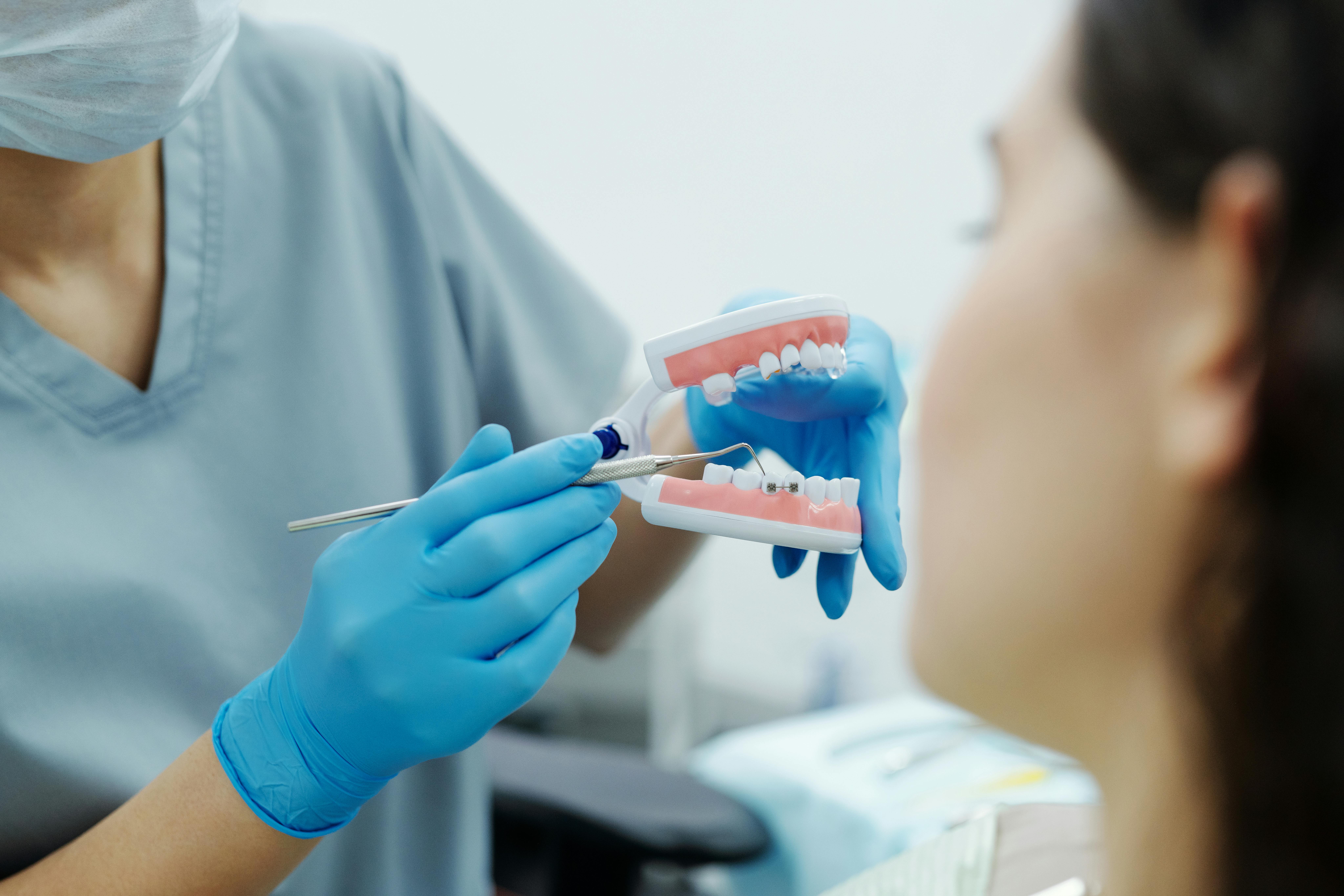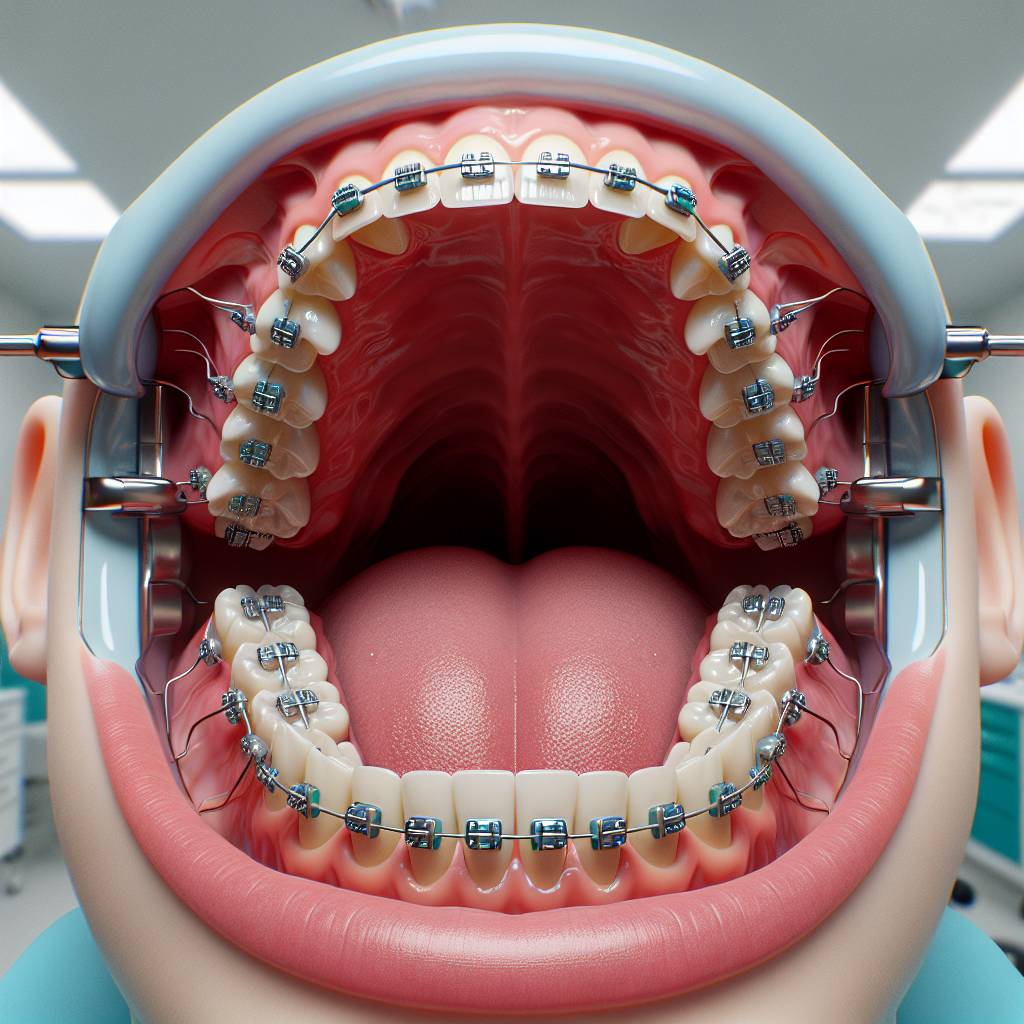Braces are an orthodontic appliance used to straighten teeth and correct improper bites. They are made up of brackets, wires, and bands that apply pressure to the teeth in order to move them into their desired position. Braces work by gradually shifting the teeth over time, allowing them to eventually settle into the correct alignment. Over time, with the help of braces, people can achieve a straight and beautiful smile they can be proud of.Braces work by applying gentle, continuous pressure on the teeth. This pressure gradually shifts them into their proper positions. The brackets, which are glued to each tooth, are connected with an archwire. The archwire is placed in the brackets and then tightened by the orthodontist at regular intervals. As the archwire is tightened, it exerts pressure on each of the teeth, and over time this will move them into their desired positions. During your regular check-ups with your orthodontist, the wire will be adjusted to ensure that your teeth are being moved in the right direction.
Advantages of Braces for Teeth Straightening
Braces are a popular and effective way to straighten teeth and improve your smile. They can also help improve your overall oral health. Orthodontic treatment with braces can correct overcrowding, misalignment, and gaps in teeth that may be difficult to clean. By improving the position of your teeth, braces can make it easier to brush and floss and reduce the risk of tooth decay or gum disease. Braces can also help improve your jaw alignment and reduce stress on the jaw joint which may reduce headaches or jaw pain.
In addition to the health benefits of braces, they can also improve the appearance of your smile. Orthodontic treatment with braces can create a more uniform look for crooked or overlapping teeth and they can even help correct an overbite or underbite. Braces are also available in a variety of materials including ceramic, metal, or clear plastic brackets which blend in with your natural tooth color making them almost invisible when worn.
Braces are generally easy to maintain as long as you practice good oral hygiene by brushing twice a day and flossing daily. You should also avoid foods that may damage the braces such as hard candy or sticky snacks. Your orthodontist will provide periodic adjustments to ensure your teeth are moving in the right direction and they may also recommend wearing rubber bands or headgear for additional pressure if needed.
Overall, braces offer many advantages for improving both the look and feel of your smile while providing added support for long-term oral health benefits. If you think orthodontic treatment with braces may be right for you, consult with an orthodontist to discuss your options and find out how you can benefit from wearing braces today!
Types of Braces for Teeth Alignment
Braces are a common orthodontic treatment for misaligned teeth. Braces can help straighten crooked teeth and close gaps between teeth, giving you a healthier, more attractive smile. The type of braces you need will depend on the severity of your misalignment and your age. Here are some of the types of braces available:
Traditional metal braces: These are the most common type of braces and consist of metal brackets that are attached to each tooth. The brackets are connected by archwires that help move the teeth into proper alignment. Traditional metal braces can be uncomfortable and require frequent adjustments.
Ceramic braces: These are similar to traditional metal braces but have clear or tooth-colored brackets that blend in with your natural tooth color. Ceramic braces are less noticeable than traditional metal braces, but they require more frequent adjustments and may not be as strong as metal braces.
Lingual braces: These are similar to traditional metal braces but they’re placed on the back side of the teeth so they’re less visible from the front. Lingual braces can be uncomfortable, require frequent adjustments, and may not be suitable for people with severe misalignment.
Invisalign: This is an alternative to traditional metal, ceramic, or lingual braces. Invisalign uses a series of clear plastic aligners that fit over your teeth like a mouthguard or retainer. Each aligner is designed to gradually shift your teeth into proper alignment over time. Invisalign is comfortable and removable, but it’s not suitable for everyone.
Your orthodontist can help you decide which type of brace is best for you based on your particular needs and goals. Braces can be an effective way to correct misaligned teeth and give you a healthier, more attractive smile.
Parts of a Brace
A brace is a device used to support or protect a weakened joint or area of the body. It is typically made up of several components, each with an important role in providing stability and comfort for the user. The main parts of a brace include straps, padding, shells, fasteners, and hinges.
Straps are the foundation of any brace and provide compression to the area they are supporting. The straps can be adjustable or non-adjustable and are generally made from elastic materials such as neoprene or nylon. They can be placed in various positions on the brace to ensure maximum comfort and stability.
Padding is another component of braces that provides both comfort and support. It can be made from foam, gel, or fleece and helps reduce friction between the brace and skin. Padding also helps distribute pressure more evenly across the body for more comfortable wear.
Shells are rigid components that provide additional support for weak joints or areas of the body needing protection. They are usually made from plastic or metal and can come in various sizes depending on the type of brace being used. Shells are generally contoured to fit more precisely against the body for more effective protection.
Fasteners are used to secure straps in place on braces so they don’t slip during use. Common fasteners include Velcro, lacing systems, buckles, clips, zippers, snaps, and hook-and-loop closures. They vary in size and shape depending on how much adjustability is needed for a particular brace type.
Hinges are specialized components included on some braces that allow for greater flexibility at specific joint locations such as elbows or knees. They come in various types such as flexible polycentric hinges, hinged shells with ratchet systems, dynamic force control hinges, and range-of motion limiters. Hinges allow users increased freedom of movement while still providing necessary support.
Orthodontic Treatment Painful?
Orthodontic treatment is generally not painful. However, mild discomfort is expected during the first few days after the braces are applied. This discomfort is caused by the pressure of the braces on the teeth and may last for a few days until your mouth gets used to them. It can be relieved with over-the-counter pain relievers such as ibuprofen or acetaminophen. If you experience severe pain or discomfort, contact your orthodontist right away.
In addition to the initial discomfort associated with getting braces, you may experience some minor discomfort while wearing them. Commonly, these are caused by broken wires or loose brackets and can usually be adjusted during regular checkups with your orthodontist. You may also experience some soreness after each orthodontic adjustment appointment; however, this should only last a few days and can be managed with over-the-counter pain relievers if necessary.
Overall, orthodontic treatment is not usually painful and any pain or discomfort experienced is usually mild and temporary. If you have any questions or concerns about pain associated with orthodontic treatment, speak to your orthodontist for more information.

Brushing and Flossing
Taking care of your teeth with braces can be a bit tricky, but it is important to keep up with your oral hygiene routine. Brushing and flossing should be done at least twice daily, with special attention paid to the areas around the brackets and wires. It is important to use a soft-bristled toothbrush and fluoride toothpaste to avoid damaging the brackets or wires. A water flosser or interdental brush can also be used to clean around the braces. Make sure to rinse thoroughly after brushing and flossing.
Mouthwash
Mouthwash should also be used in addition to brushing and flossing, as it helps reduce plaque buildup and removes food particles that may get caught in your braces. Choose an alcohol-free mouthwash, as alcohol can irritate your gums and mouth tissues. Swish the mouthwash for 30 seconds before spitting it out.
Eating Habits
It is important to pay attention to what you eat while wearing braces, as certain foods can damage the brackets or wires. Avoid sticky, hard, or chewy foods that may get stuck in your braces or pull off the bracket glue. Foods like popcorn, hard candy, nuts, gum, ice cubes, and beef jerky should also be avoided. Instead, opt for softer foods like yogurt or mashed potatoes that won’t harm your braces.
Regular Visits
Visiting your orthodontist regularly during treatment is equally important for taking care of your teeth with braces. During these visits, your orthodontist will check for any problems with the brackets or wires and make adjustments if needed. They will also check for any signs of cavities or other issues that need attention.
By following these tips on how to take care of your teeth with braces, you can ensure that you maintain healthy teeth throughout treatment!
Average Cost of Braces
The average cost of braces can vary greatly depending on the type of braces you choose and your location. Generally, traditional metal braces are the least expensive option, with most people paying around $3,000 to $7,000 for full treatment. Ceramic braces cost slightly more, usually starting at around $4,000. Lingual braces are the most expensive option, with an average price tag of $8,000 to $10,000.
In addition to the type of braces you select, where you live and the severity of your orthodontic condition can also have a significant impact on the total cost. For instance, in certain states where orthodontic services are in high demand and supply is limited due to a lack of providers, prices may be higher than average. Additionally, if your case is more complicated than expected or requires additional treatments such as jaw repositioning or headgear wear in addition to traditional braces, this can add significantly to your final bill.
Finally, some orthodontists offer flexible payment plans or discounts for cash payments that can help lower the overall cost of treatment. Be sure to shop around and compare prices before committing to a particular doctor or treatment plan.
How Long Does it Take to Straighten Teeth with Braces?
The amount of time it takes to straighten teeth with braces can vary greatly from person to person. Generally, the average time frame for treatment is between 18 and 24 months, although some people may need shorter or longer periods of time. The exact length of treatment depends on the severity of misalignment and other factors such as age and cooperation.
Braces typically start with an initial consultation where an orthodontist will assess your situation and make a plan for how long your treatment will take. The orthodontist will then recommend braces or other corrective devices, which should be worn for a minimum of 20 hours per day.
Once your braces have been fitted, you can expect to have regular check-ups every six weeks or so. During these visits, the orthodontist will check your progress and make any necessary adjustments to ensure that they are working correctly. It’s important to attend these appointments in order to ensure that your teeth are being moved in the right direction.
The amount of time it takes for braces to work can also depend on how well you cooperate with treatment. It is important that you follow all instructions given by your orthodontist in order to get the most out of your braces. This includes wearing them for at least 20 hours each day, brushing and flossing regularly, avoiding hard foods that could damage them, and attending regular check-ups as recommended by your orthodontist. If you don’t cooperate with instructions or miss appointments, this could significantly delay the process of straightening your teeth with braces.
It’s important to note that while it usually takes 18-24 months to straighten teeth with braces, this isn’t always the case. Some people may need shorter periods of time while others may require more extensive treatments that could take several years in order to achieve desired results. Ultimately, how long it takes for braces to work depends on individual factors such as age, misalignment severity, and cooperation throughout treatment.

Conclusion
Braces are an effective treatment for misaligned teeth and can help improve the health and appearance of your smile. Brackets, wires, and other orthodontic appliances work together to move your teeth into the correct position over time. With the help of an experienced orthodontist, you can have a straighter, healthier smile.
The process of getting braces can be time-consuming and uncomfortable at times, but with proper care and regular check-ups with your orthodontist, you will be able to achieve the desired results. Braces may take some getting used to but the end result is worth it. Your straightened smile can give you more confidence and improve your oral health in the long run.
In conclusion, braces are an effective way to straighten teeth that are crooked or overcrowded. With a commitment to regular check-ups and consistent care of your braces, you will be able to enjoy a beautiful smile for years to come.

